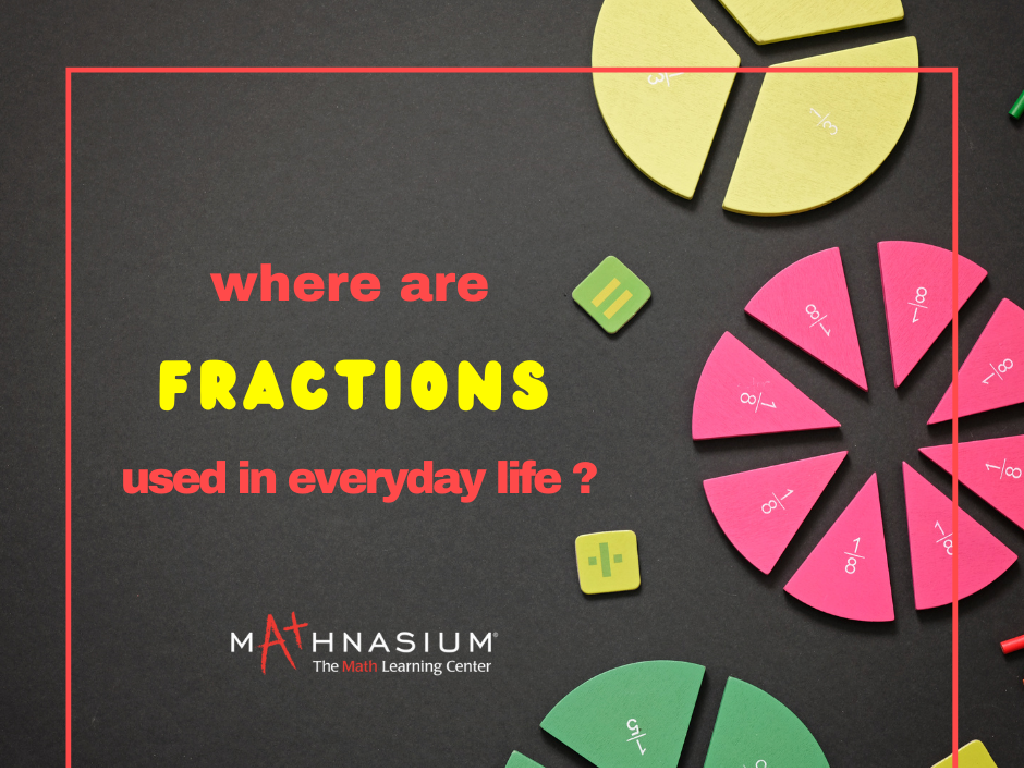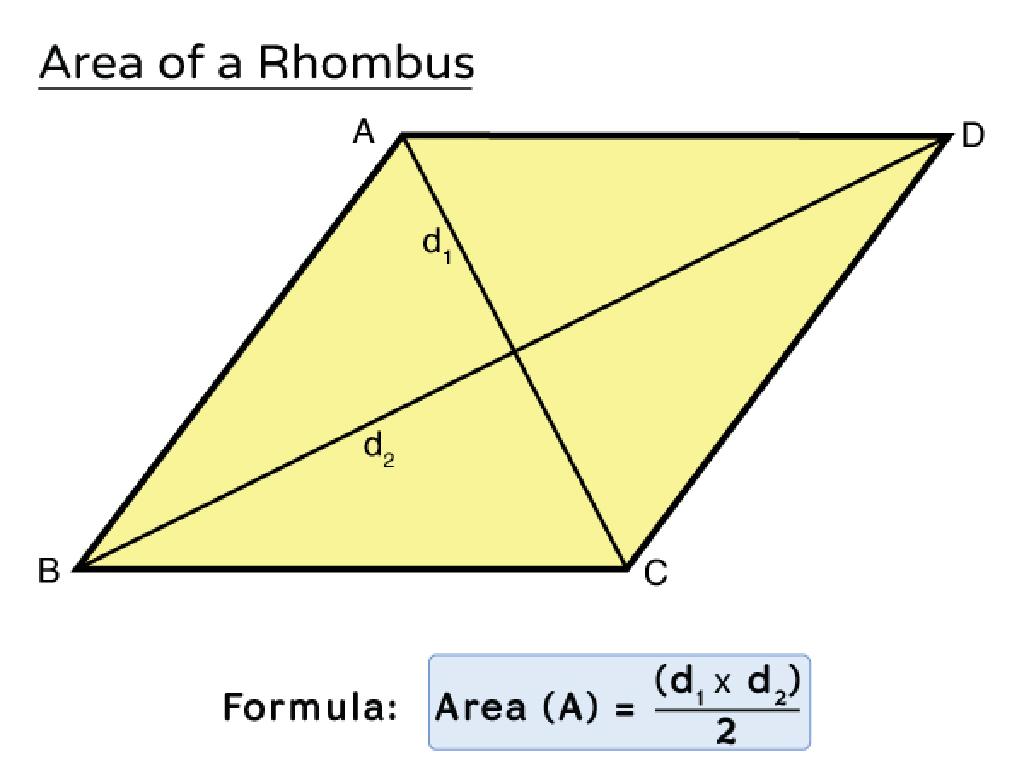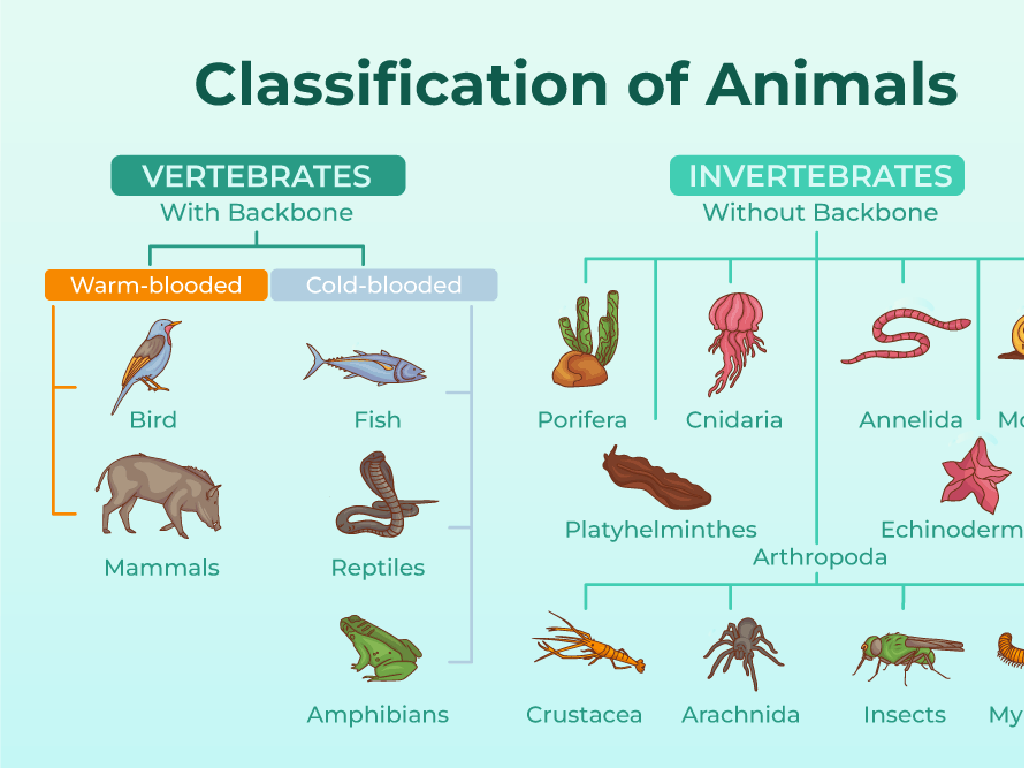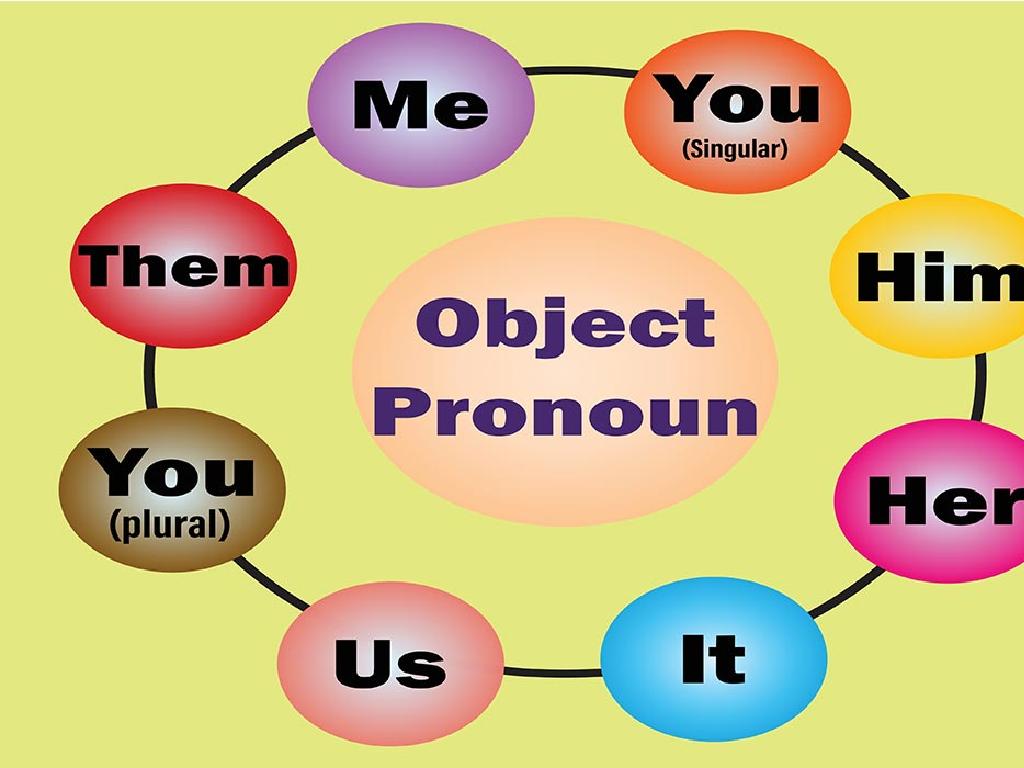Compare Cells And Cell Parts
Subject: Science
Grade: Sixth grade
Topic: Cells
Please LOG IN to download the presentation. Access is available to registered users only.
View More Content
Welcome to the World of Cells!
– Cells: Life’s Building Blocks
– Smallest unit of life, making up all living things.
– Cells’ Role in Organisms
– Essential for life functions and maintaining life.
– Comparing Cell Structures
– Different cells have unique parts with specific roles.
– Preview of Cell Comparison
|
This slide introduces students to the fundamental concept that cells are the basic building blocks of all living organisms. Emphasize that every living thing is made up of cells, and these cells have various functions that are vital for life. Highlight the importance of understanding cell structure and function as a key aspect of biology. Today’s lesson will focus on comparing different types of cells and their parts, which will help students appreciate the diversity and complexity of life at the cellular level. Encourage students to think about how different cell types might look and function as we dive deeper into the topic.
What is a Cell?
– Cells: Basic unit of life
– Smallest structure that performs all life processes.
– Cells’ role in organisms
– Cells work together to keep organisms alive.
– Shared cell characteristics
– All cells have a membrane, cytoplasm, and DNA.
– Exploring cell diversity
|
This slide introduces the concept of cells as the fundamental building blocks of all living organisms. Emphasize that cells are the smallest units that can carry out all the processes we associate with life, such as growth, reproduction, and response to the environment. Discuss how cells work together in multicellular organisms to perform complex functions and maintain life. Highlight common characteristics that all cells share, such as having a cell membrane, cytoplasm, and genetic material (DNA). Use this opportunity to set the stage for comparing different types of cells and their specialized parts in future lessons.
Comparing Cell Types
– Prokaryotic vs. Eukaryotic cells
– Prokaryotic cells lack a nucleus, while Eukaryotic cells have a nucleus.
– Plant vs. Animal cells
– Plant cells have cell walls and chloroplasts, unlike animal cells.
– Single-celled organisms
– Examples include bacteria and some algae.
– Multi-celled organisms
– Examples include humans, animals, and trees.
|
This slide aims to compare and contrast different types of cells. Prokaryotic cells are simpler and do not contain a nucleus, while Eukaryotic cells are more complex with a defined nucleus. Highlight the unique features of plant cells, such as the presence of a cell wall and chloroplasts for photosynthesis, which are absent in animal cells. Discuss examples of single-celled organisms like bacteria, which consist of only one cell, versus multi-celled organisms like humans, which are made up of many cells. Encourage students to think about the diversity of cell types and how they are adapted to their functions.
Cell Parts and Functions
– Identify parts of a cell
– Nucleus, mitochondria, cell membrane, etc.
– Functions of cell parts
– Nucleus: controls cell; Mitochondria: energy production
– Cell parts collaboration
– Parts work in unison like a mini factory
– Keeping the cell alive
|
This slide aims to introduce students to the various components of a cell and their respective functions. Start by explaining the cell as the basic unit of life, much like the building blocks of all living organisms. Highlight the nucleus as the ‘brain’ of the cell, the mitochondria as the ‘powerhouse’ producing energy, and the cell membrane as the ‘gatekeeper’ controlling what enters and leaves the cell. Emphasize how these parts, along with others like the endoplasmic reticulum and Golgi apparatus, work together seamlessly to maintain cellular processes. Use analogies such as comparing the cell to a factory or city to help students visualize the interdependent nature of cell parts. Encourage students to think of questions about cell functions for discussion in the next class.
Cell Parts in Depth
– The nucleus: A cell’s HQ
– The nucleus contains genetic material and orchestrates activities.
– Mitochondria: Cellular power plants
– Mitochondria create energy for the cell through respiration.
– Chloroplasts: Unique to plants
– Chloroplasts in plant cells capture sunlight to make food.
– Comparing cell organelles
|
This slide delves into the specific functions of various cell organelles. The nucleus acts as the ‘brain’ of the cell, housing DNA and coordinating cell activities. Mitochondria are responsible for energy production through the process of cellular respiration, which is crucial for cell survival. Chloroplasts are specialized organelles found only in plant cells, playing a key role in photosynthesis by converting sunlight into chemical energy. Encourage students to compare these organelles, noting their unique features and functions. Discuss how these parts work together to keep the cell functioning properly. Use analogies like a city or factory to help students visualize the roles of each organelle.
Activity: Cell Model Creation
– Craft your own cell model
– Choose plant or animal cell
– Label each cell part
– Identify organelles like the nucleus, mitochondria, chloroplasts (plant cells), etc.
– Present your model to class
|
This class activity is designed to help students understand the structure of cells by creating a 3D model using craft materials. Students can choose to create either a plant or animal cell. Provide a variety of materials such as clay, beads, yarn, and construction paper. Encourage creativity but also accuracy in representing the different parts of the cell. Once completed, students should label each part of their cell model, including organelles like the nucleus, mitochondria, and chloroplasts (for plant cells). Finally, students will present their models to the class, explaining the function of each cell part. This will reinforce their understanding of cell structure and the differences between plant and animal cells. Possible variations of the activity could include creating a cell model out of edible materials or using digital tools to create a virtual cell model.
Comparing Cell Parts: Plant vs. Animal
– Compare organelles in plant & animal cells
– Both have nucleus, mitochondria, but plant cells have chloroplasts, cell walls
– Discuss: Plant cells’ chloroplasts
– Chloroplasts allow plants to photosynthesize, producing their own food
– Animal cells lack chloroplasts
– Cell walls’ role in plant cells
– Cell walls provide structure and support for plant cells, not found in animal cells
|
This slide aims to highlight the key similarities and differences between plant and animal cell organelles. Start by comparing the common organelles like the nucleus and mitochondria, then focus on the unique aspects of plant cells, such as chloroplasts and cell walls. Engage the class in an interactive discussion about the function of chloroplasts in photosynthesis and why animal cells do not have them. Emphasize the structural role of the cell wall in plant cells. Encourage students to think about how these differences relate to the functions and lives of plants and animals.
Microscopic Exploration of Cells
– Observe slides of plant & animal cells
– Use microscopes to see cell details
– Identify different cell parts
– Look for nucleus, cytoplasm, cell membrane, etc.
– Discuss findings with classmates
– Share what you’ve noticed, ask questions
– Understand cell structure differences
– Notice how plant cells have a cell wall, but animal cells do not
|
This slide is designed to guide students through a hands-on activity where they will use microscopes to observe the intricate details of plant and animal cells. Students should focus on identifying the various parts of the cells, such as the nucleus, cytoplasm, and cell membrane. Encourage them to discuss their observations with their classmates to enhance their understanding through collaborative learning. Highlight the importance of recognizing the differences between plant and animal cells, such as the presence of a cell wall in plant cells. This activity will help solidify their understanding of cell structure and function. Provide guidance on microscope handling and safety, and prepare a list of questions to prompt discussion among students.
Review and Quiz Time: Cell Comparison
– Recap key cell concepts
– Take a pop quiz on cell parts
– Match each cell part with its function
– Discuss quiz answers together
– Why is the nucleus like a ‘brain’ for the cell?
– Clarify any doubts
– Ask questions if you’re unsure about any part
|
This slide is designed to reinforce the day’s learning through a quick review followed by an interactive pop quiz. The quiz will involve matching cell parts such as the nucleus, mitochondria, and ribosomes with their respective functions. After the quiz, lead a class discussion to go over the answers, providing an opportunity for students to understand the reasoning behind each match. Encourage students to ask questions and seek clarifications on any part of the lesson they found challenging. This activity will help solidify their understanding of cell structures and their functions, an essential part of the cell biology unit.
Wrapping Up: Cells and Their Parts
– Recap: Comparing cells and parts
– Homework: Draw and label cell parts
– Illustrate both plant and animal cells, label organelles like nucleus, mitochondria, etc.
– Focus on plant and animal cells
– Highlight differences like cell wall in plant cells, chloroplasts
– Discussion prep for next class
|
As we conclude today’s lesson, ensure students have a clear understanding of the similarities and differences between plant and animal cells, as well as the function of various cell parts. For homework, they should draw and label each part of both a plant and an animal cell, paying close attention to the unique features of each. Encourage creativity but also accuracy in their diagrams. In the next class, be ready to facilitate a discussion where students will share their drawings and explain the function of each labeled part, reinforcing their understanding through peer learning.






